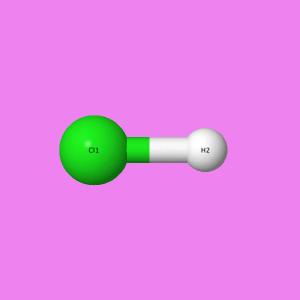Quantum Calculations of Hydrogen Chloride's Molecular Properties
| Base Set |
Bond Length (nm) |
Dipole (Debye) |
Energy (Hartree) |
Absorption Frequency (1/cm) |
| AM1 |
0.128 |
1.383973 |
-14.2652 |
------------- |
| PM3 |
0.127 |
1.379246 |
-12.2254 |
------------- |
| 6-21G |
0.129 |
1.87323 |
-460.0253 |
71241.49 |
| 6-31G |
0.128 |
1.468739 |
-460.0562 |
67252.95 |
| DZV |
0.131 |
1.897531 |
-460.0283 |
69409.16 |
| Literature |
0.127 |
1.08 |
------------ |
------------ |
Listed below are are the optimized geometries of hydrogen chloride calculated using MOPAC and ad initio theories and several base sets including AM, PM3, 6-21G, 6-31G, and DZV. Ad intio 6-31G determined to have the gratest dissociation energy of -460.0562 Hartrees at internuclear radii of 0.128 nm.
Using the unrestricted Hartree-Fock method and the optimized geometry with the greatest dissociated energy (6-31G) the highest occupied molecular orbitals and the lowest unoccupied molecular orbitals were calculated.
The HOMO diagram shows the highest electron density to be primarily centered at the chlorine atom with Pz orientation. This can be explained because of chlorine's high electronegitivity.
The LUMO diagram shows the lowest electron densities being located along the opposite ends of HCl with a slightly higher density at the chlorine's end.
The electrostatic diagram shows a high electrostatic potential centered around the chlorine atom and a low potential energy entered at far end of the hydrogen atom. Slightly left of the hydrogen atom's center there appears to be a region of zero net potential portrayed as green.
According to the the rule of thumb for calculating degrees of vibrational freedom, HCl's optimized geometry was determined to possess only one vibration (stretching). This frequency was determined to be 2995.47 vibrations per second.
The partial atomic charges of HCl are determined through the electron distribution throughout the molecule. The partial charges at each atom equal but opposite in sign. For a molecule such as HCl the are fairly simple but for molecules such as 2,2'-chloro biphenyl the partial charges vary significantly throughout the molecule due to the effect of nearby partial charges.
Page skeleton and JavaScript generated by export to web function using Jmol 14.2.15_2015.07.09 2015-07-09 22:22 on Apr 3, 2018.
This will be the viewer


If your browser/OS combination is Java capable, you will get snappier performance if you use Java